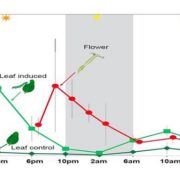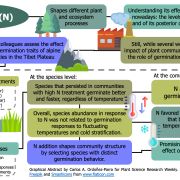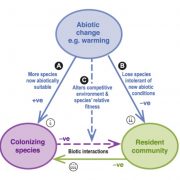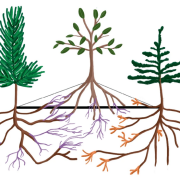Century-old museum specimens predict a timeline for declines in monarch butterflies and their host milkweed (PNAS)
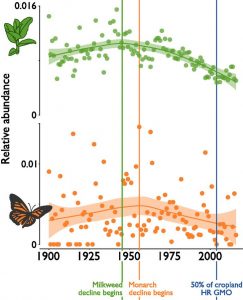 Milkweeds are often found in agriculture fields, and are susceptible to herbicides sprayed in such fields. A decline in milkweeds, which provide food for monarch butterflies, has been historically linked to the wide cultivation of herbicide-resistant genetically modified (GM) crops. Boyle et al. attempt to reconstruct a timeline of monarch and milkweed abundance based on museum and herbaria specimens collected over a century (1900 – 2016). Based on their analyses, the authors conclude that milkweed and monarch populations started to decrease around 1950, decades before the introduction of genetically modified crops. The authors hypothesize that multiple events such as merging of smaller farms into larger farms and increased herbicide use might have triggered the decline of monarch butterfly instead of a single event, i.e., the use of GM crops. The authors clearly articulate potential biases and limitations in estimating insect abundance based on museum and herbaria collections. Nevertheless, this study provides an interesting approach based on systematic analysis of collection data for predicting broad trends in host-insect dynamics over long periods. (Summary by Saima Shahid) PNAS 10.1073/pnas.1811437116.
Milkweeds are often found in agriculture fields, and are susceptible to herbicides sprayed in such fields. A decline in milkweeds, which provide food for monarch butterflies, has been historically linked to the wide cultivation of herbicide-resistant genetically modified (GM) crops. Boyle et al. attempt to reconstruct a timeline of monarch and milkweed abundance based on museum and herbaria specimens collected over a century (1900 – 2016). Based on their analyses, the authors conclude that milkweed and monarch populations started to decrease around 1950, decades before the introduction of genetically modified crops. The authors hypothesize that multiple events such as merging of smaller farms into larger farms and increased herbicide use might have triggered the decline of monarch butterfly instead of a single event, i.e., the use of GM crops. The authors clearly articulate potential biases and limitations in estimating insect abundance based on museum and herbaria collections. Nevertheless, this study provides an interesting approach based on systematic analysis of collection data for predicting broad trends in host-insect dynamics over long periods. (Summary by Saima Shahid) PNAS 10.1073/pnas.1811437116.


